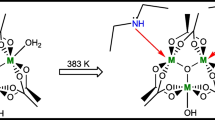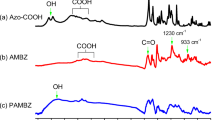Abstract
A series of new porous aromatic frameworks (PAA-VTMS) co-cured by diethynylbenzene (DEB) and vinyltrimethoxysilane (VTMS) have been described. Thermally treated PAA-VTMS were also investigated. When the ratio of DEB to VTMS was 1:1 (PAA-VTMS-4), it showed characteristic pores with uniform diameter, confirmed by scanning electron microscope (SEM) and transmission electron microscopy (TEM) analyses. The surface area of PAA-VTMS-4 was up to 457 m2/g and its pore size was 7 nm, related to the hyper-cross-linked structure with plentiful benzene units. The co-cured PAA-VTMS samples whose DEB/VTMS ratios were higher or less than 1:1 showed low surface area. CO2 uptake of PAA-VTMS-4 was 83 cm3/g at 0 °C and 72 cm3/g at 25 °C. The temperature of 5% weight loss of PAA-VTMS-4 was 388 °C in nitrogen and 346 °C in air. The surface area of the thermally treated sample (OPAA-VTMS-4) was decreased, but its CO2 uptake was as high as 115 cm3/g at 0 °C and 105 cm3/g at 25 °C. The OPAA-VTMS-4 sample almost did not decompose in N2, and the temperature of its 5% weight loss was 450 °C in air. It showed that PAA-VTMS with its new porous aromatic framework can be used at high temperature.











Similar content being viewed by others
References
Haszeldine RS (2009) Carbon capture and storage: how green can black be? Science 325:1647–1652
Macdowell N, Florin N, Buchard A, Hallett J, Galindo A, Jackson G, Adjiman CS, Williams CK, Shah N, Fennell P (2010) An overview of CO2 capture technologies. Energy Environ Sci 3:1645–1669
Germain J, Hradil J, Fréchet JMJ, Svec F (2006) High surface area nanoporous polymers for reversible hydrogen storage. Chem Mater 18:4430–4435
Lee JY, Wood CD, Bradshaw D, Rosseinsky MJ, Cooper AI (2006) Hydrogen adsorption in microporous hypercrosslinked polymers. Chem Commun 25:2670–2672
Germain J, Fréchet JMJ, Svec F (2007) Hypercrosslinked polyanilines with nanoporous structure and high surface area: potential adsorbents for hydrogen storage. J Mater Chem 17:4989–4997
Germain J, Fréchet JM, Svec F (2009) Nanoporous, hypercrosslinked polypyrroles: effect of crosslinking moiety on pore size and selective gas adsorption. Chem Commun 12:1526–1528
Dawson R, Su F, Niu H, Wood CD, Jones JTA, Khimyak YZ, Cooper AI (2008) Mesoporous poly(phenylenevinylene) networks. Macromolecules 41:1591–1593
Germain J, Svec F, Fréchet JMJ (2008) Preparation of size-selective nanoporous polymer networks of aromatic rings: potential adsorbents for hydrogen storage. Chem Mater 20:7069–7076
Bildirir H, Osken I, Schmidt J, Ozturk T, Thomas A (2016) Chemical redox properties of a donor–acceptor conjugated microporous dithienothiophene-benzene co-polymer formed via, suzuki-miyaura cross-coupling. ChemistrySelect 1:748–751
Schmidt J, Weber J, Epping JD, Antonietti M, Thomas A (2009) Microporous conjugated poly(thienylenearylene) networks. Adv Mater 21:702–705
Germain J, Fréchet JMJ, Svec F (2009) Nanoporous polymers for hydrogen storage. Small 5:1098–1111
Dawson R, Cooper AI, Adams DJ (2013) Chemical functionalization strategies for carbon dioxide capture in microporous organic polymers. Polym Int 62:345–352
Xie Z, Wang C, Dekrafft KE, Lin W (2011) Highly stable and porous cross-linked polymers for efficient photocatalysis. J Am Chem Soc 133:2056–2059
Merino E, Verde-Sesto E, Maya EM, Corma A, Iglesias M, Sánchez F (2014) Mono-functionalization of porous aromatic frameworks to use as compatible heterogeneous catalysts in one-pot cascade reactions. Appl Catal A Gen 469:206–212
Zhao J (2014) A nanoporous organic polymer constructed from a 1,3,5-triazine derivative via ethynyl cyclotrimerization reaction: synthesis and carbon dioxide capture. J Chem Pharm Res 6:322–326
Zhang J, Luo J, Zhang X (2015) A carbazolic porous organic framework as an efficient, metal-free visible-light photocatalyst for organic synthesis. Acs Catal 5:2250–2254
Liu J, Lam JWY, Tang BZ (2009) Acetylenic polymers: syntheses, structures, and functions. Chem Rev 109:5799–5867
Ren H, Ben T, Sun F, Guo M, Jing X, Ma H, Cai K, Qiu S, Zhu G (2011) Synthesis of a porous aromatic framework for adsorbing organic pollutants application. J Mater Chem 21:10348–10353
Yuan Y, Sun F, Ren H, Jing X, Wang W, Ma H, Zhao H, Zhu G (2011) Targeted synthesis of a porous aromatic framework with a high adsorption capacity for organic molecules. J Mater Chem 21:13498–13502
Hanková V, Slováková E, Zedník J, Vohlídal J, Sivkova R, Balcar H, Zukal A, Brus J, Sedláček J (2011) Polyacetylene-type networks prepared by coordination polymerization of diethynylarenes: new type of microporous organic polymers. Macromol Rapid Comm 33:158–163
Zukal A, Slováková E, Balcar H, Sedláček J (2013) Polycyclotrimers of 1,4-diethynylbenzene, 2,6-diethynylnaphthalene, and 2,6-diethynylanthracene: preparation and gas adsorption properties. Macromol Chem Phys 214:2016–2026
Stahlová S, Slováková E, Vaňkátová P, Zukal A, Kubů M, Brus J, Bondarev D, Moučka R, Sedláček J (2015) Chain-growth copolymerization of functionalized ethynylarenes with 1,4-diethynylbenzene and 4,4′-diethynylbiphenyl into conjugated porous networks. Eur Polym J. 67:252–263
Yan Z, Ren H, Ma H, Yuan R, Yuan Y, Zou X, Sun F, Zhu G (2013) Construction and sorption properties of pyrene-based porous aromatic frameworks. Microporous Mesoporous Mater 173:92–98
Normatov J, Silverstein MS (2007) Interconnected silsesquioxane—organic networks in porous nanocomposites synthesized within high internal phase emulsions. Chem Mater 20:1571–1577
Kanamori K (2014) Monolithic silsesquioxane materials with well-defined pore structure—ERRATUM. J Mater Res 30:2773–2786
Ogawa M, Kikuchi T (1998) Preparation of self-standing transparent films of silica–surfactant mesostructured materials and the conversion to porous silica films. Adv Mater 10:1077–1080
Itoh M, Inoue K, Iwata K, Ishikawa J, Takenaka Y (1997) A heat-resistant silicon-based polymer. Adv Mater 9:1187–1190
Itoh M, Inoue K, Iwata K, Mitsuzuka M, Takenaka Y (1997) New highly heat-resistant polymers containing silicon: poly(silyleneethynylenephenyleneethynylene)s. Macromolecules 30:694–701
Wang F, Zhang J, Huang J, Yan H, Huang F, Du L (2006) Synthesis and characterization of poly(dimethylsilyleneethynylenephenyleneethynylene) terminated with phenylacetylene. Polym Bull 56:19–26
Wu Y, Yu R, Hu L, Li Q, Zhu C (2014) Thermal stability of cocured blends of vinyl trimethoxysilane and aryl acetylene resins with different posttreatments. J Appl Polym Sci 131:631–644
Sing KSW (1982) Reporting physisorption data for gas/solid systems with special reference to the determination of surface area and porosity. Pure Appl Chem 54:2201–2221
Zhang C, Yang X, Zhao Y, Wang X, Yu M, Jiang J (2015) Bifunctionalized conjugated microporous polymers for carbon dioxide capture. Polymer 61:36–41
Dawson R, Adams DJ, Cooper AI (2011) Chemical tuning of CO2 sorption in robust nanoporous organic polymers. Chem Sci 2:1173–1177
Martín CF, Stöckel E, Clowes R, Adams DJ, Cooper AI, Pis JJ, Rubiera F, Pevida C (2011) Hypercrosslinked organic polymer networks as potential adsorbents for pre-combustion CO2 capture. J Mater Chem 21:5475–5483
Acknowledgements
This work was supported by the National Natural Science Foundation of China (contract Grant Number 51003030).
Author information
Authors and Affiliations
Corresponding author
Rights and permissions
About this article
Cite this article
Yu, X., Yu, R., Li, Q. et al. Porous aromatic frameworks of co-cured diethynylbenzene (DEB) and vinyltrimethoxysilane (VTMS) with good thermo-oxidative stability. Iran Polym J 26, 413–421 (2017). https://doi.org/10.1007/s13726-017-0530-4
Received:
Accepted:
Published:
Issue Date:
DOI: https://doi.org/10.1007/s13726-017-0530-4




